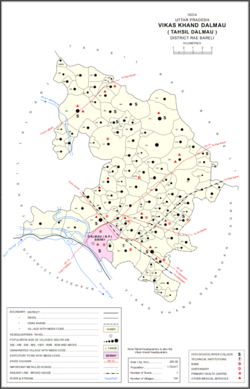Pilkha is a village in Dalmau block of Rae Bareli district, Uttar Pradesh, India.[2] It is located 9 km from Lalganj, the nearest large town.[3] As of 2011, it has a population of 2,122 people, in 375 households.[2] It has one primary school and no healthcare facilities and does not host a permanent market or weekly haat.[2]
Pilkha | |
|---|---|
Village | |
 Map showing Pilkha (#885) in Dalmau CD block | |
| Coordinates: 26°12′33″N 81°01′08″E / 26.2093°N 81.018983°E[1] | |
| Country India | |
| State | Uttar Pradesh |
| District | Raebareli |
| Area | |
• Total | 1.951 km2 (0.753 sq mi) |
| Population (2011)[2] | |
• Total | 2,122 |
| • Density | 1,100/km2 (2,800/sq mi) |
| Languages | |
| • Official | Hindi |
| Time zone | UTC+5:30 (IST) |
| Vehicle registration | UP-35 |
History
editPilkha was founded by Mohan Singh, a ninth-generation descendant of the Bais ruler Rana Doman Deo through his fourth son Tribhuban Sah.[4] Tribhuban Sah had originally been given the village of Jagatpur Kotaha for his maintenance, but his descendants failed in their attempts to form a taluqa.[4] After Mohan Singh founded Pilkha, the village was taken over by the Rana of Khajurgaon.[4] Later, Thakur Maharaj Bakhsh obtained the sanad for Pilkha and three other villages . When Thakur Maharaj Bakhsh died without a Will, then Pilkha was devolve to his son Thakur Sukhraj Bakhsh Singh. Thakur Sukhraj Bakhsh Singh, Stated his lands directed towards his son. Thakur Prem Pratap Singh.[citation needed]
Three generations after Thakur Maharaj Bakhsh was Thakur Prem Pratap Singh , who divided his lands among his four sons.[3] The Oldest, Dhirendra Pratap Singh , Hirendra Pratap Singh , Dushyant Pratap Singh and the youngest , Kaushlendra Pratap Singh.
The 1951 census recorded Pilkha as comprising 3 hamlets, with a total population of 804 people (402 male and 402 female), in 177 households and 156 physical houses.[5] The area of the village was given as 489 acres.[5] 84 residents were literate, 76 male and 8 female.[5] The village was listed as belonging to the pargana of Dalmau and the thana of Dalmau.[5] There was a primary school at that point, which had an attendance of 93 students on 1 January of that year.[5]
The 1961 census recorded Pilkha as comprising 3 hamlets, with a total population of 834 people (425 male and 409 female), in 183 households and 167 physical houses.[6] The area of the village was given as 489 acres.[6]
The 1981 census recorded Pilkha as having a population of 1,180 people, in 224 households, and having an area of 195.06 hectares.[3] The main staple foods were listed as wheat and rice.[3]
The 1991 census recorded Pilkha as having a total population of 1,343 people (659 male and 684 female), in 254 households and 242 physical houses.[7] The area of the village was listed as 195 hectares.[7] Members of the 0-6 age group numbered 290, or 22% of the total; this group was 50% male (145) and 50% female (145).[7] Members of scheduled castes numbered 512, or 38% of the village's total population, while no members of scheduled tribes were recorded.[7] The literacy rate of the village was 27% (262 men and 96 women).[7] 523 people were classified as main workers (316 men and 207 women), while 131 people were classified as marginal workers (8 men and 123 women); the remaining 689 residents were non-workers.[7] The breakdown of main workers by employment category was as follows: 395 cultivators (i.e. people who owned or leased their own land); 56 agricultural labourers (i.e. people who worked someone else's land in return for payment); 0 workers in livestock, forestry, fishing, hunting, plantations, orchards, etc.; 0 in mining and quarrying; 36 household industry workers; 5 workers employed in other manufacturing, processing, service, and repair roles; 0 construction workers; 5 employed in trade and commerce; 1 employed in transport, storage, and communications; and 25 in other services.[7]
References
edit- ^ "Geonames Search". Do a radial search using these coordinates here.
- ^ a b c d e "Census of India 2011: Uttar Pradesh District Census Handbook - Rae Bareli, Part A (Village and Town Directory)" (PDF). Census 2011 India. pp. 306–30. Retrieved 18 August 2021.
- ^ a b c Census 1981 Uttar Pradesh: District Census Handbook Part XIII-A: Village & Town Directory, District Rae Bareli (PDF). 1982. pp. 158–9. Retrieved 18 August 2021.
- ^ a b c Nevill, H.R. (1905). Rai Bareli: A Gazetteer, Being Volume XXXIX Of The District Gazetteers Of The United Provinces Of Agra And Oudh. Allahabad: Government Press. p. 77. Retrieved 3 November 2021.
- ^ a b c d e Census of India, 1951: District Census Handbook Uttar Pradesh (42 - Rae Bareli District) (PDF). Allahabad. 1955. pp. 116–7, 208. Retrieved 3 November 2021.
{{cite book}}: CS1 maint: location missing publisher (link) - ^ a b Census 1961: District Census Handbook, Uttar Pradesh (39 - Raebareli District) (PDF). Lucknow. 1965. pp. lxxx-lxxxi of section "Dalmau Tahsil". Retrieved 18 August 2021.
{{cite book}}: CS1 maint: location missing publisher (link) - ^ a b c d e f g Census 1991 Series-25 Uttar Pradesh Part-XII B Village & Townwise Primary Census Abstract District Census Handbook District Raebareli (PDF). 1992. pp. xxiv–xxviii, 200–1. Retrieved 21 October 2021.
